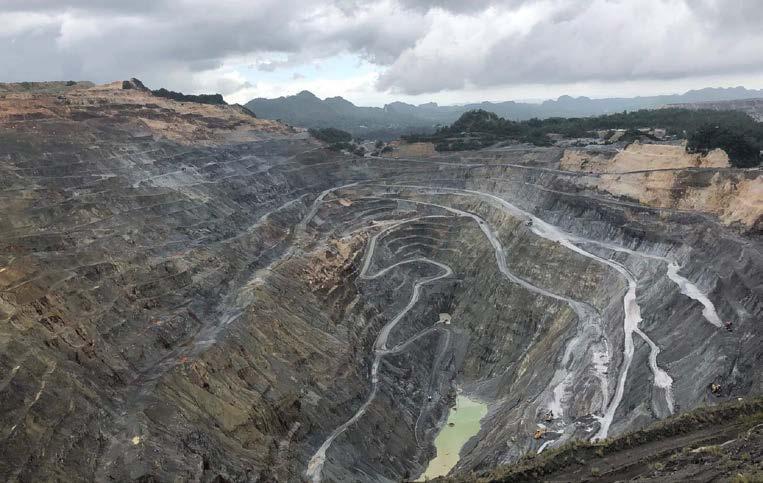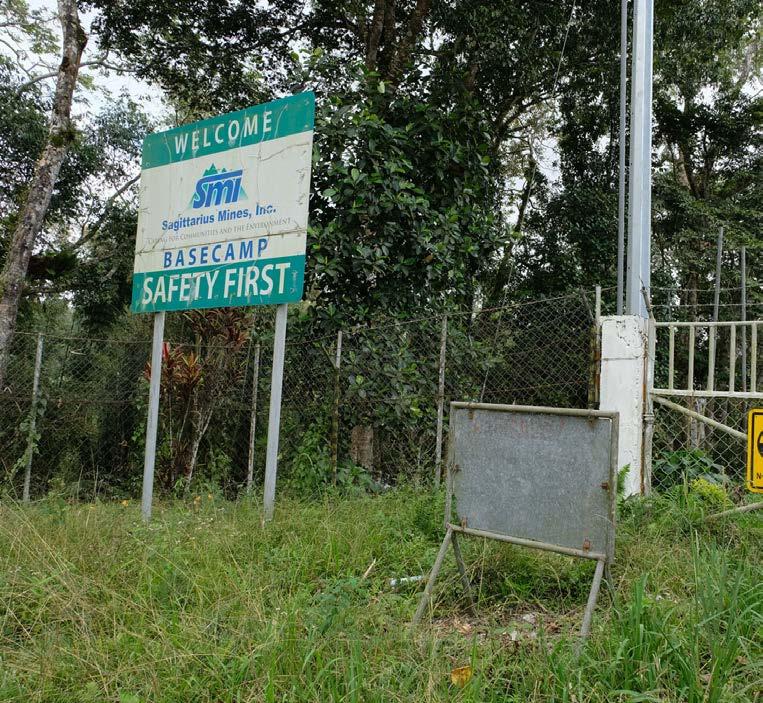
9 minute read
Representatives end plan to construct the biggest copper mine in the Philip pines
GLOBAL
Representatives end plan to construct the biggest copper mine in the Philippines
Officials in the southern Philippines have terminated a $5.9 billion project to make use of Southeast Asia’s largest known undeveloped copper and gold reserves. However, they have revealed the possibility of the endeavor being restored.
The Metropolitan Council of Tampakan, house to 40,000 people in the district of South Cotabato, affirms that Sagittarius Mines, Inc. (SMI) failed to honor its side of the arrangement governing the development of the mine.
That bargain, the community principal contract (MPA), is expected to be reviewed and upgraded every four years, yet this hasn’t been done since 2009. There were efforts to assess the MPA, yet the mayor and various other local reps were omitted from the settlements, the council stated. “After scrutiny, there are stipulations in the MPA that are considered unclear, unfavorable to residents of Tampakan and unduly link the hands of the local government unit [LGU] of Tampakan,” the council stated in a resolution dated August 10 but made public on August 14.
“As such, the LGU cannot rest and fold its arms not to intervene in any activity launched by its people if, certainly, their legal rights have actually been gone against unlike some stipulations of the contract.” The MPA was currently a done deal instead of being discussed with the federal government, the resolution said. Metropolitan lawmakers claim they are no more interested in evaluating or upgrading the 2009 MPA with the firm but are open to producing or formulating a new agreement, which means SMI can still seek the mammoth Tampakan task under a brand-new community agreement.
The resolution has actually been sent to appropriate government firms, however, SMI has yet to release a statement since the time this post was released. Mongabay sought comment from SMI officials yet did not receive a reaction from the mining firm.
If accepted, the Tampakan job would be the biggest copper mine in the Philippines as well as among the largest in the world. The site is forecasted to yield an average of 375,000 lots of copper and 360,000 ounces of gold in concentrate annually through a 17-year period. In 1995, the Philippine government approved the Tampakan project, the contract to explore and create the location’s natural resource via an economic or technical aid contract (FTAA).
The MPA took effect in 1997, and also ever since SMI has paid Tampakan community a minimum of 40 million pesos ($822,370 at current prices), or approximately 2.5 million pesos ($51,400) a year in conjunction with its economic commitments, according to a 2013 state audit. However, the terms of the deal are “unbalanced,” the
council noted in its recent decision. Days before the council released its resolution, Tampakan Mayor Leonard Escobillo slammed the rental rate that SMI was set to pay for the genealogical lands of the Blaan, the ethnic tribal team whose hill house will certainly be impacted by the task.
Escobillo stated that the mining firm was set to rent out the indigenous lands for 160,000 pesos (around $3,300) per hectare for 25 years, which equates to 6,400 pesos ($131) a year or 533.33 pesos ($11) every 30 days.
Escobillo, who succeded his dad, Leonardo, a staunch fan of mining throughout his three terms as the community’s mayor, stated the land rental rate belonged to the negotiations for obtaining the totally free, previous and also enlightened authorization (FPIC) of the impacted neighborhood—one of the major needs for the company to wage the job, along with city government endorsements.
“I believe there’s no justice because [of price],” Escobillo said on August12. “You rent out one hectare of land and you’ll utilize it for 25 years, that’s only 500 pesos a month. Just how will a family live with such [an amount].”
Alyansa Tigil Mina (ATM), a nationwide advocacy group whose name converts as Partnership Against Mining, lauded the Tampakan Metropolitan Council for ending the manage SMI. It additionally prompted Head of State Rodrigo Duterte, who vocally prohibited open-pit mining in 2017, to get an exec review of the Tampakan contract.
“[Tampakan authorities] have actually exercised the spirit and also substance of neighborhood freedom in ensuring the basic welfare in addition to guaranteeing a protected atmosphere of their constituents,” Jaybee Garganera, of ATM, claimed in a declaration. “The people of Tampakan and the Blaan Aboriginal communities affected should have to be heard in their denial of this massive as well as possibly devastating mining project.”
PUSHBACK FROM CLERGY AND ALSO COMMUNISTS
Nestled some 1,300 meters above water level, the recommended mining site continues to be untapped in the hills of Tampakan more than three decades after the discovery of copper and gold books there.
Its ownership has changed hands several times. Australian company Western Mining Corporation (WMC) made the initial exploration in 1994, before offering the mining rights to SMI. The nationwide federal government accepted the transfer of the FTAA from WMC to SMI in 2001. Exploration activity returned in 2002 with investments from Indophil Resources NL, likewise an Australian business, as well as the Mindanao-based empire Alsons (Alcantara and Sons) Team.
International miners Xstrata Copper and Glencore Plc. later became SMI shareholders; Glencore would certainly go on to obtain Xstrata in 2013. In 2015, Alsons Team gained control of the Tampakan job after Glencore pulled out, and by December 2017, SMI’s business framework is “one hundred percent Filipino,” according to the Philippine government’s Mines and Geosciences Bureau (MGB).

The cancellation of the local contract is the most recent setback for the Tampakan job, already blocked by a ban on open-pit mining imposed by the South Cotabato provincial federal government since 2010.
SMI and its supporters have challenged the legality of the ban, claiming the extraction technique does not break national mining legislations. A regional court has yet to render a choice in the event. The project faced difficulties even before the restriction put pressure a decade ago. These consist of protection dangers from communist rebels, and also opposition from the neighborhood Catholic church, ecologists and some members of the Blaan people.
On New Year’s Day in 2008, communist rebels stormed and burned the SMI base camp in the town of Tablu in Tampakan municipality. The rebels got away with numerous weapons drawn from business guards. The church, on the other hand, has actually long turned down the mining task, citing its prospective ecological threats in addition to concerns over food safety and also the Aboriginal peoples’ human rights in the damaged area.
GLOBAL
In 2017, the former Environment Secretary, Gina Lopez, terminated the Tampakan job’s Ecological Conformity Certificate (ECC) “because of environmental and social worries.” However, in July 2020, the MGB local office exposed that Rodrigo Duterte’s office had actually recovered the ECC, a choice that was in effect as early as May 6, 2019.
In a comparable move, the firm’s 25-year FTAA, which was readied to run out on March 21, 2020, was expanded for an additional 12 years in an order that was dated from June 8, 2016, but only made public in January 2020. The 12-year extension will certainly permit SMI to operate the mine up until 2032, with the opportunity of a renewal until 2057.
GETTING READY FOR EXTRACTION
Before the discontinuation of the metropolitan contract, the company had actually been gearing up for the business production phase. In the past two years, SMI has spent at least 103 million pesos ($2.1 million) on fixing 17.4 kilometers (10.8 miles) of roads in a minimum of two villages in the location, according to the 2019 firm record.
The company calls itself a “liable miner,” pointing out the commendations it received from the Presidential Mineral Market Environmental Awards in 2006, 2009, 2010, 2011, 2012 and 2013. Local radio promotions have actually been running in the current months repeating this “responsible miner” tag and touting the economic increase that the mine would certainly have in transforming inadequate areas and also transforming hundreds of lives with work production. Power supply lines, a significant assistance center for the mining operation, have now been put in place in the mountains of Tampakan, along with canals as well as gabions, while expedition research studies to determine the ground’s safety for various other support facilities are still underway. On a slope near the SMI base camp in the Tablu village, employees were seen in January putting soil erosion blankets in place made from coconut husks.
Escobillo said that month that SMI aims to begin mining procedures in three years if it can acquire the needed licenses from the pertinent government firms, including the ECC from the Division of Environmental and Natural Resources (DENR) and also FPIC from the National Compensation on Indigenous Peoples (NCIP).
a decade ago.
ABORIGINAL RESISTANCE AND BLOODSHED
While some aboriginal leaders support the job, others oppose it. Blaan tribal leader Daguel Capion, who used to lead an armed team against the project and has actually admitted on the website to having eliminated at least three construction workers in 2011, warned of turmoil and more bloodshed should SMI wage digging deep into the huge mineral deposits. In 2013, SMI reduced its operations, retrenching 1,000 workers as 42 | SKILLINGS MINING REVIEW October 2020 part of a revised work plan that sought, among other points, to get authorization from various government degrees and agencies to get the project to the commercial manufacturing phase.
“In the years resulting in and also during the expedition stage, the company would certainly approach as well as seek advice from us,” Capion told Mongabay in January. “Yet nowadays, there are no more arrangements; the area is being maintained blind. I hope the business will certainly be more clear to us.”
At the very least 6 of Capion’s instant relatives and also loved ones, including his other half, Juvy, and also their two youngsters, were killed in separate circumstances within the Tampakan task location. Juvy and the youngsters were killed in October 2012 during a military operation targeted at detaining Capion, who was then encountering murder charges for the deaths of three individuals helping a roadway job funded by SMI the year before.
Capion, who used to work as a neighborhood relations officer for SMI prior to occupying arms against the Tampakan job, was consequently detained in 2015 in the neighboring Sarangani province but released nearly a year later as a result of insufficient proof.
Before his apprehension, he had admitted to eliminating the building workers and also to have been connected to several various other alleged murder and tried murder instances targeting federal government soldiers as well as company guards in the mine growth site.
Capion, who is extremely concerned by his clan, and for several years has been identified by conservationists and the neighborhood Catholic church as a legitimate district leader until his group’s disgruntlement turned fierce, cautioned that “a lot more lives will be lost if the huge mining task is permitted to proceed” on the Blaan ancestral land.









